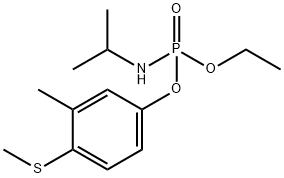페나미포스 C화학적 특성, 용도, 생산
개요
Fenamiphos is a colorless crystalline substance. Solubility in water is
400 mg/L (20 ?C). It is soluble in polar organic solvents.
Log Kow = 3.3(20 ?C). It is stable in aqueous media; DT
50
(22 ?C) at pH 4, 7, and 9 are 1, 8, and 3 yr.
화학적 성질
Fenamiphos is a colorless crystal or a tan, waxy solid. It is non-corrosive to metals and breaks down readily in strong acids and bases. Fenamiphos is used as a nematicide and an insecticide. It is sparingly soluble in water, but readily soluble in dichloromethane, isopropanol, and toluene. It is used primarily for the control of nematodes and thrips on citrus, grapes, peanuts, pineapples, tobacco, turf, and ornamentals. There are no residential uses for fenamiphos. The US EPA has grouped fenamiphos as an RUP owing to its high acute toxicity and toxicity to wildlife. Reports have indicated that the manufacture and sale of fenamiphos is to be phased out by 2007–2008.
용도
Fenamiphos is primarily used to control nematodes in a wide
range of crops and in turf. It will also control mites and sucking insects in crops.
일반 설명
Brown waxy solid or colorless solid. Used as a nematocide.
공기와 물의 반응
Fenamiphos is hydrolyzed by strong acids and strong alkalis.
반응 프로필
Organothiophosphates, such as Fenamiphos, are susceptible to formation of highly toxic and flammable phosphine gas in the presence of strong reducing agents such as hydrides. Partial oxidation by oxidizing agents may result in the release of toxic phosphorus oxides.
위험도
Toxic by inhalation and skin contact. Questionable carcinogen.
건강위험
Fenamiphos is highly toxic orally, by inhalation, and by absorption through the skin. (Non-Specific -- Parathion) Death may occur from respiratory failure.
화재위험
(Non-Specific -- Organophosphorus Pesticide, n.o.s.) Container may explode in heat of fire. Fire and runoff from fire control water may produce irritating or poisonous gases. Emits toxic fumes of nitrogen oxides, phosphorus oxides, and sulfur oxides when heated to decomposition.
농업용
Nematicide, Insecticide: A U.S. EPA restricted Use Pesticide (RUP).
Fenamiphos is an organophosphate nematicide used to
control a wide variety of nematode (roundworm) pests.
Nematodes can live as parasites on the outside or the inside
of a plant. They may be free living or associated with cyst
and root-knot formations in plants. Fenamiphos is used on
a variety of plants including tobacco, turf, bananas, pineapples,
citrus and other fruit vines, some vegetables, and
grains. The compound is absorbed by roots and is then distributed
throughout the plant. Fenamiphos, as is typical of
other organophosphates, blocks the enzyme acetylcholinesterase
in the target pest. The pesticide also has secondary
activity against other invertebrates such as sucking insects
and spider mites.
상품명
BAY 68138®; Bayer 68138®;
NEMACUR®; NEMACURP®
Safety Profile
Poison by ingestion,
inhalation, and skin contact. When heated to
decomposition it emits very toxic fumes of
NOx, POx, and SOx.
환경귀착
Soil. Oxidizes in soil to the corresponding sulfone and sulfoxide (Lee et al., 1986). Fenamiphos rapidly degraded in Arredondo soil to fenamiphos sulfone and at the sametime to the corresponding phenol. The half-life in this soil is 38–67 days (Ou and Rao, 1986).
Surface Water. In estuarine water, the half-life of fenamiphos was 1.80 days (Lacorte et al., 1995).
Chemical/Physical. Emits toxic fumes of phosphorus, nitrogen and sulfur oxides when heated to decomposition (Sax and Lewis, 1987; Lewis, 1990).
신진 대사 경로
Fenamiphos is an effective nematicide with both protectant and curative
action. Free-living, ecto- and endo-parasitic, cyst-forming and root knot
nematodes are controlled. Foliarly applied compound is translocated in
plants to the roots and there is evidence that both translocation and optimum
anti-cholinesterase and nematicide activity require oxidation of the
thiomethyl group to the sulfoxide or the sulfone. These thiooxidation
products are much more easily hydrolysed than fenamiphos itself and
hydrolytic degradation in the environment most probably occurs via the
formation of these intermediates.
신진 대사
The oxidation of the thiomethyl group to the sulfoxide
and sulfone is required for both translocation and
nematicidal activity in plants. The oxidation products are
more susceptible to hydrolysis than fenamiphos itself.
In mammals, orally administered fenamiphos is rapidly
metabolized to the sulfoxide and sulfone, followed by subsequent hydrolysis, conjugation, and excretion in the
urine. N-Dealkylation also occurs. The DT
50 in soils
is several weeks; the major degradation products are
fenamiphos sulfoxide and sulfone and their phenols.
페나미포스 준비 용품 및 원자재
원자재
준비 용품








